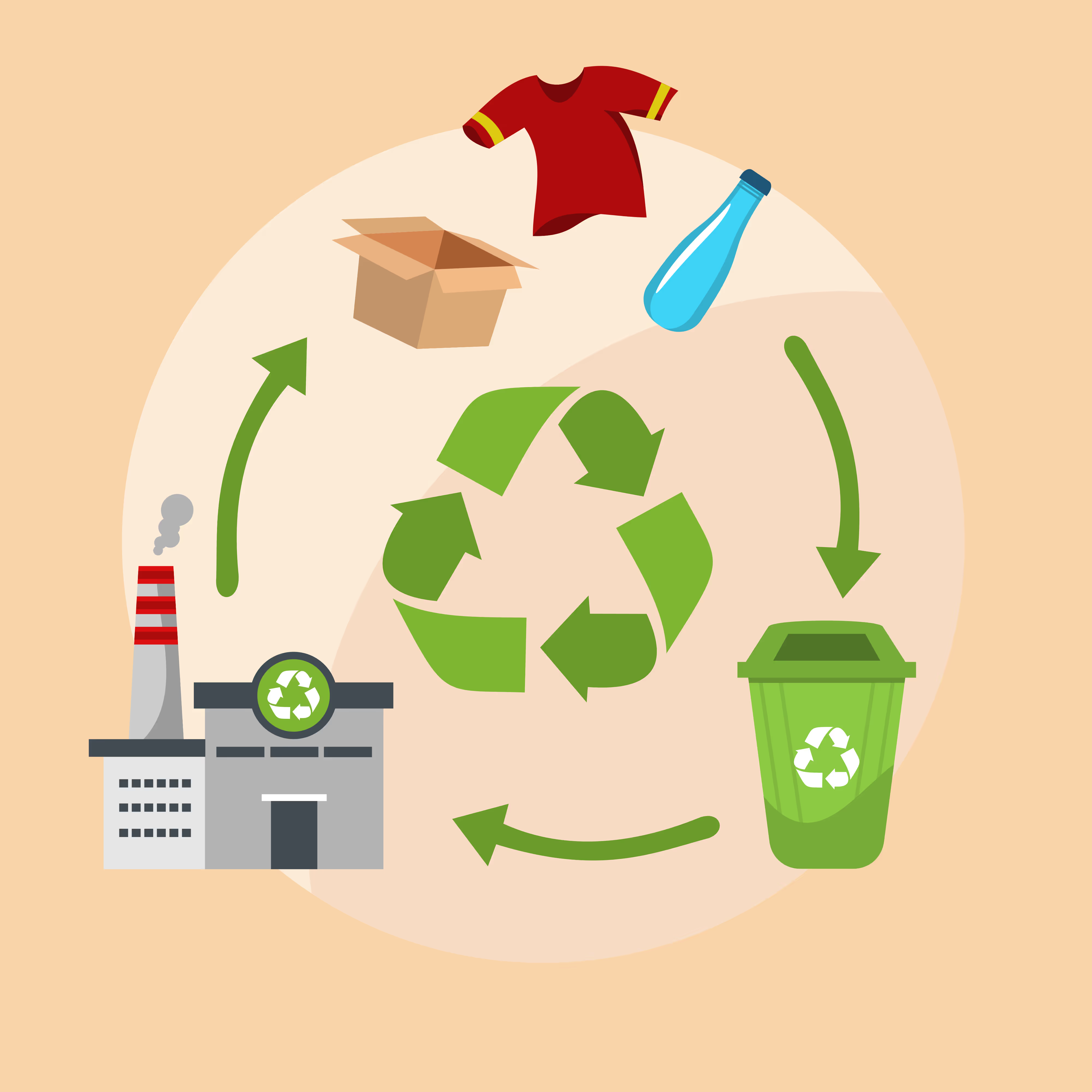The concept of sustainability is gaining increasing importance. But what exactly does sustainability mean, and how can we achieve it? One simple framework to guide us is the 6 Rs of sustainability. These Rs are Reduce, Reuse, Recycle, Rethink, Refuse, and Repair. Each R represents a different action we can take to lessen our impact on the environment and promote sustainable living.
What is sustainability?
Sustainability is the practice of meeting the needs of the present without compromising the ability of future generations to meet their own needs. It's about balancing economic, social, and environmental factors to mitigate climate change and its negative impact on our society and planet.

Credit: Unsplash
At its core, sustainability is about making choices that benefit us now and future generations. This means considering the impacts of our actions on the environment, society, and economy and striving to minimise any negative consequences. It requires us to rethink our current way of living, adopt practices that are more harmonious with nature, and respect human rights.
What are the 6 Rs?
The 6 Rs of sustainability are Reduce, Reuse, Recycle, Rethink, Refuse, and Repair.

Reduce
The first R, "Reduce," is about reducing the number of products and services we use. This concept revolves around consuming less to waste less.
So, how can we incorporate this into our daily lives? For companies, this can involve reducing energy consumption by investing in energy-efficient machinery or transitioning to renewable energy sources. It could also mean reducing material waste by implementing lean manufacturing techniques, rethinking packaging to minimise material use, or even transitioning to a digital-first strategy to reduce paper consumption.
Take, for example, a tech company that reduces its energy use by consolidating its data centres into more energy-efficient cloud platforms. This cuts operational costs and lessens the company's environmental impact, aligning with global sustainability goals. By continuously looking for ways to optimise, businesses can reduce their carbon footprint and operational expenses, driving long-term sustainability.
Reuse
Reuse simply means finding new ways to use items instead of throwing them away. It's about extending the lifespan of products by finding alternative purposes for them. Instead of automatically discarding something, consider how it could be repurposed or given to someone else who could use it.
For example, a company might reuse old office furniture, refurbish it instead of buying new pieces, or repurpose outdated equipment for alternative organisational functions. Additionally, businesses can implement asset-sharing programs, where equipment or materials no longer needed in one department can be transferred to another instead of discarded.
A great example would be a manufacturing company that reuses materials from returned or unsold products. By disassembling these items, they can harvest usable components for new production, reducing the need to source new materials. This cuts costs, reduces waste, and demonstrates a solid commitment to circular economy principles.
By giving old items a new lease on life, we can significantly reduce the amount of waste in landfills. Moreover, reusing allows us to avoid unnecessary purchases, saving money and resources in the long term. Plus, it provides an opportunity to get creative and explore innovative ways to repurpose everyday items.
Recycle
Recycling involves converting used materials into new products, reducing the need for raw materials and minimising waste. While recycling may seem familiar to many, its accessibility can vary depending on the location. However, regardless of local recycling programmes, companies can still take proactive steps to contribute.
.jpeg)
Recycling is a crucial aspect of sustainability. It returns items to an earlier stage in their production cycle, such as raw materials. It's a step to be taken only when reusing an item isn't feasible, hence why it falls as the third R in the sustainability hierarchy.
The significance of recycling lies in its ability to preserve resources, reduce the burden on natural ecosystems, and decrease the volume of waste destined for landfills. By recycling, we mitigate the need to extract new resources from the planet, leading to cleaner air and water in our surroundings.
Many communities offer curbside recycling services to participate in recycling efforts while recycling facilities are often accessible even if doorstep collection isn't available. Some supermarkets also provide recycling facilities, particularly for electronic devices and batteries.
Recycling alone isn't sufficient to achieve sustainability. To truly impact environmental preservation and resource conservation, it's essential to consider and implement all six Rs.
Rethink
Rethink calls for businesses to adopt a more strategic, long-term approach to sustainability by questioning traditional practices and considering the broader impact of their operations. This involves re-evaluating business models, product lifecycles, and resource usage to create more sustainable systems.
For companies, "Rethink" means shifting away from the assumption that growth must come at the expense of environmental health. Instead, businesses can innovate by developing products and services that minimise resource use, embrace circular economy principles, and deliver value without unnecessary consumption.
For instance, a company might rethink its supply chain by sourcing materials locally to reduce carbon emissions from transportation or consider whether producing a physical product can be replaced with a digital alternative. By critically analysing each stage of their operations, companies can discover opportunities to streamline processes, reduce waste, and meet the increasing demand for environmentally responsible business practices.
This mindset also encourages companies to challenge the status quo and find new ways to deliver value to customers—whether through services that promote resource sharing, subscription models that reduce the need for ownership, or products designed with modularity and longevity in mind.
Refuse
Let's explore the fifth R: "Refuse." Refusing involves actively choosing not to purchase or consume unnecessary or unsustainable products. Refuse encourages companies to critically assess their supply chain, production processes, and partnerships and actively refuse unsustainable practices or materials. Companies can set a strong example of corporate responsibility by choosing not to engage with products, suppliers, or practices contributing to environmental harm.
For instance, a company might refuse to use non-recyclable or single-use packaging materials in its products. Similarly, businesses can refuse to partner with suppliers who do not adhere to ethical or environmentally responsible standards.
At an individual level, employees can also refuse unsustainable options, whether by opting out of plastic-heavy promotional items or encouraging the workplace to adopt more sustainable alternatives, such as reusable coffee cups or eco-friendly office supplies. This approach fosters a culture of mindful decision-making, where both companies and individuals make more sustainable choices and take steps toward reducing their environmental footprint.
Repair
The sixth R, Repair, involves fixing broken or damaged items instead of discarding them. The idea is to extend the lifespan of products and minimise waste by addressing issues rather than replacing entire items.
To extend their usefulness, businesses can adopt repair programs for machinery, technology, and even office furniture. For example, companies can invest in repair services or establish in-house maintenance teams to address issues and refurbish assets instead of discarding malfunctioning equipment. This approach reduces the environmental impact of sourcing new materials and manufacturing new products.
Some companies even take it a step further by offering repair services to customers. Tech companies, for example, can empower consumers to repair their devices through repair kits, replacement parts, or workshops. This promotes sustainability and builds customer loyalty by providing long-term support for products.
On an individual level, repairing encourages us to develop practical skills and resourcefulness. It empowers us to take control of our possessions and actively participate in their maintenance and upkeep (mending a tear in clothing, fixing a broken appliance, or patching up furniture, for example).
Repairing also fosters a sense of appreciation for the value and craftsmanship of our belongings. By investing time and effort into repairing items, we develop a deeper connection with the objects in our lives and cultivate a mindset of sustainability and resourcefulness.
How do you apply the 6 Rs for your company?
If you wonder how to apply the 6 Rs for your company, here are some practical suggestions :
- Audit your current practices: Conduct a comprehensive audit of your company's operations to identify areas where the 6 Rs can be implemented. Assess your consumption patterns, waste generation, and resource usage to pinpoint opportunities for improvement ;
- Educate employees: Ensure that all employees are familiar with the principles of the 6 Rs and understand their importance for sustainability. You can provide training sessions or workshops to educate your staff on how they can incorporate these principles into their daily work routines ;
- Encourage employees to minimise waste: Implement measures such as using digital documents instead of printing, reducing packaging for products, and opting for energy-efficient appliances and equipment ;
- Promote a reuse culture: You can encourage employees to find creative ways to repurpose items instead of discarding them. Set up designated areas for reusable office supplies, such as pens, folders, and packaging materials ;
- Think about an intelligent recycling programme: Provide clearly labelled recycling bins throughout the workplace and educate employees on what can and cannot be recycled ;
- Explore alternative approaches that prioritise sustainability: Don’t hesitate to encourage brainstorming sessions and idea-sharing among employees to generate innovative solutions for reducing waste and conserving resources ;
- Evaluate your supply chain and procurement processes: This will allow you to identify opportunities to refuse unnecessary or unsustainable products. Prioritise suppliers that align with your company's sustainability goals and values ;
- Implement a repair and maintenance programme: You can prolong the lifespan of company assets and equipment, for example, by inviting the employees to report and address issues promptly to prevent unnecessary replacements.
The impact of the 6 Rs of sustainability on customers' behaviour
The 6 Rs of sustainability also have an essential effect on customers' behaviour. Here is what you need to know :
- Reduce: Customers will likely make more conscious purchasing decisions When they become more aware of the importance of reducing consumption and waste. They may opt for products with minimal packaging or choose items that have a longer lifespan, reducing the need for frequent replacements ;
- Reuse: Encouraging customers to embrace the concept of reusing products can lead to a shift away from single-use items and disposable goods. Customers may seek out reusable alternatives, such as refillable containers or durable products that can be repurposed for different uses ;
- Recycle: Promoting recycling initiatives can lead customers to dispose of their waste and recycle materials whenever possible properly. Here, your company can provide convenient recycling facilities or offer incentives for recycling to incentivise customers to participate in sustainable practices ;
- Rethink: By prompting customers to rethink their consumption habits, businesses can significantly influence them to make more sustainable choices. This may involve educating customers about the environmental impact of their purchases and encouraging them to consider the lifecycle of products before making a purchase ;
- Refuse: You may be surprised, but encouraging customers to refuse unnecessary or unsustainable products can lead to a more discerning approach to consumption. Customers may become more selective about the products they buy, opting for items that align with their values and priorities ;
- Repair: Promoting repair services to allow customers to repair their products can foster an even better culture of longevity and durability. Customers will become more inclined to invest in high-quality, easily repaired products rather than disposable goods that need frequent replacement.
Understanding the three pillars of sustainability

Credit: Plan A
People, the social pillar
The social pillar of sustainability focuses on ensuring equity and well-being for all members of society. It seeks to address the needs of individuals while also considering the collective welfare of communities.
This pillar advocates for universal access to essential resources and services, regardless of socioeconomic status or geographic location.
A vital social pillar principle is social justice, which promotes equality, inclusivity, and human rights. It recognises every individual's inherent dignity and worth and strives to eliminate barriers that prevent people from fulfilling their potential.
Planet, the environmental pillar
The environmental pillar of sustainability underscores the imperative of safeguarding our planet and responsibly managing its resources. It compels us to adopt practices that promote ecological balance, preserve biodiversity, and mitigate the impact of human activities on the natural world.
One of the primary objectives of the environmental pillar is to address climate change by curbing greenhouse gas emissions and transitioning to renewable energy sources.
But you must remember that the environmental pillar also emphasises the importance of adopting environmentally friendly practices in all aspects of life, from agriculture and industry to transportation and waste management. The goals are to minimise pollution, conserve resources, and promote a healthier, more sustainable planet for future generations.
Profit, the economic pillar
Finally, the economic pillar of sustainability recognises that profit should not be the sole focus of businesses.
This pillar means that we should consider the long-term viability of economic activities alongside their environmental and social impacts. Successful businesses of the future are those that effectively balance profitability with sustainability, recognising that financial success is intertwined with responsible resource management and consideration for the well-being of the broader community. That’s it!
Start your sustainability journey with Plan A. Schedule a call today.




.jpg)


.avif)
